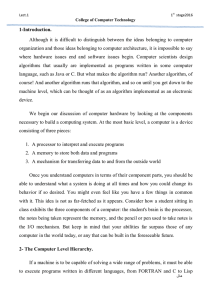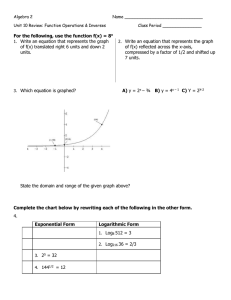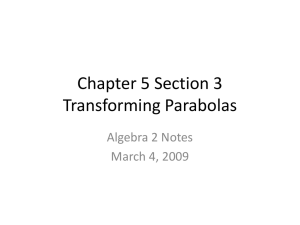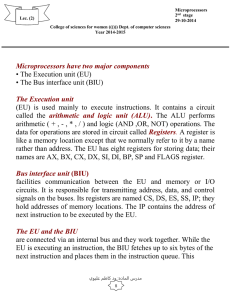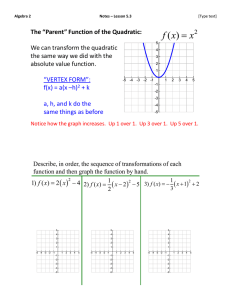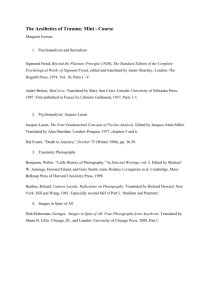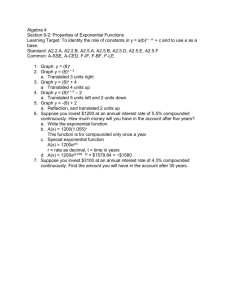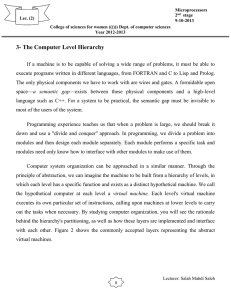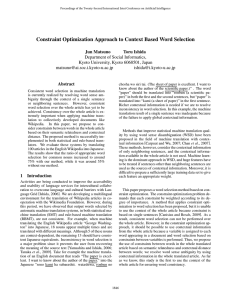1-Introduction.
advertisement
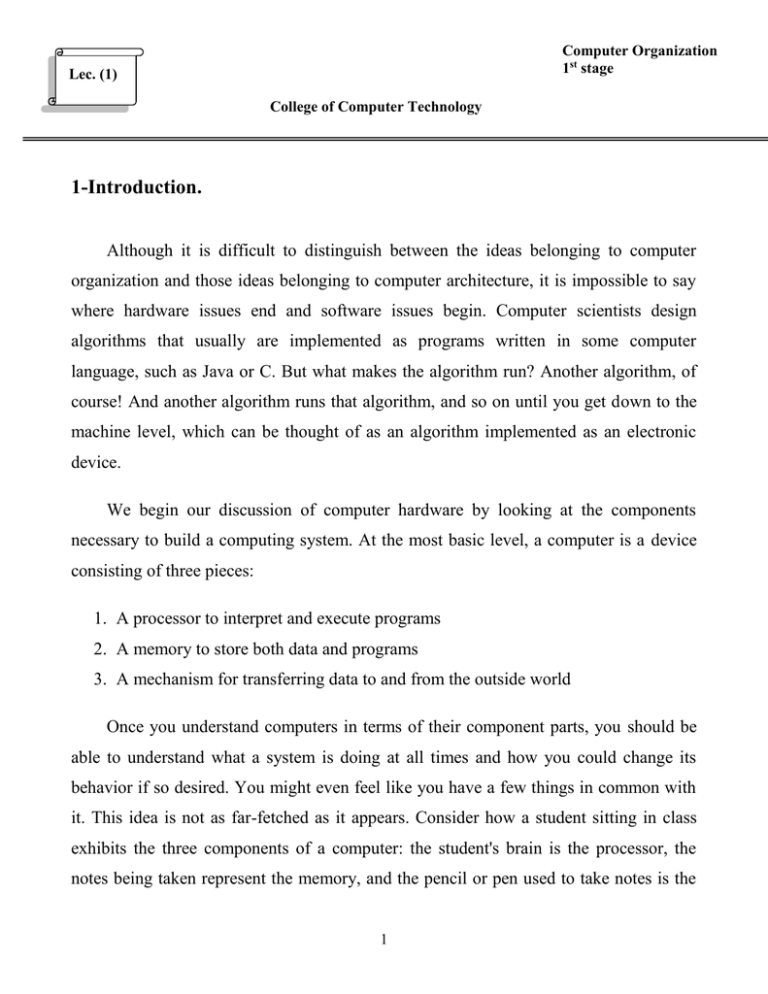
Computer Organization 1st stage Lec. (1) College of Computer Technology 1-Introduction. Although it is difficult to distinguish between the ideas belonging to computer organization and those ideas belonging to computer architecture, it is impossible to say where hardware issues end and software issues begin. Computer scientists design algorithms that usually are implemented as programs written in some computer language, such as Java or C. But what makes the algorithm run? Another algorithm, of course! And another algorithm runs that algorithm, and so on until you get down to the machine level, which can be thought of as an algorithm implemented as an electronic device. We begin our discussion of computer hardware by looking at the components necessary to build a computing system. At the most basic level, a computer is a device consisting of three pieces: 1. A processor to interpret and execute programs 2. A memory to store both data and programs 3. A mechanism for transferring data to and from the outside world Once you understand computers in terms of their component parts, you should be able to understand what a system is doing at all times and how you could change its behavior if so desired. You might even feel like you have a few things in common with it. This idea is not as far-fetched as it appears. Consider how a student sitting in class exhibits the three components of a computer: the student's brain is the processor, the notes being taken represent the memory, and the pencil or pen used to take notes is the 1 I/O mechanism. But keep in mind that your abilities far surpass those of any computer in the world today, or any that can be built in the foreseeable future. 2- The Computer Level Hierarchy. If a machine is to be capable of solving a wide range of problems, it must be able to execute programs written in different languages, from FORTRAN and C to Lisp and هائل Prolog. The only physical components we have to work with are wires and gates. A formidable open space—a semantic gap—exists between these physical components and a high-level language such as C++. For a system to be practical, the semantic gap must be invisible to most of the users of the system. Programming experience teaches us that when a problem is large, we should break it down and use a "divide and conquer" approach. In programming, we divide a problem into modules and then design each module separately. Each module performs a specific task and modules need only know how to interface with other modules to make use of them. Computer system organization can be approached in a similar manner. Through the principle of abstraction, we can imagine the machine to be built from a hierarchy of levels, in which each level has a specific function and exists as a distinct hypothetical machine. We call the hypothetical computer at each level a virtual machine. Each level's virtual machine executes its own particular set of instructions, calling upon machines at lower levels to carry out the tasks when necessary. By studying computer organization, you will see the rationale behind the hierarchy's partitioning, as well as how these layers are implemented and interface with each other. Figure 1 shows the commonly accepted layers representing the abstract virtual machines. 2 Figure 1: The Abstract Levels of Modern Computing Systems Level 6, the User Level, is composed of applications and is the level with which everyone is most familiar. At this level, we run programs such as word processors, graphics packages, or games. The lower levels are nearly invisible from the User Level. Level 5, the High-Level Language Level, consists of languages such as C, C++, FORTRAN, Lisp, Pascal, and Prolog. These languages must be translated (using either a compiler or an interpreter) to a language the machine can understand. Compiled languages are translated into assembly language and then assembled into machine code. (They are translated to the next lower level.) The user at this level sees very little of the lower levels. Even though a programmer must know about data types and the instructions available for those types, she need not know about how those types are actually implemented. Level 4, the Assembly Language Level, encompasses some type of assembly language. As previously mentioned, compiled higher-level languages are first translated 3 to assembly, which is then directly translated to machine language. This is a one-to-one translation, meaning that one assembly language instruction is translated to exactly one machine language instruction. By having separate levels, we reduce the semantic gap between a high-level language, such as C++, and the actual machine language (which consists of 0s and 1s). Level 3, the System Software Level, deals with operating system instructions. This level is responsible for multiprogramming, protecting memory, synchronizing processes, and various other important functions. Often, instructions translated from assembly language to machine language are passed through this level unmodified. Level 2, the Instruction Set Architecture (ISA), or Machine Level, consists of the machine language recognized by the particular architecture of the computer system. Programs written in a computer's true machine language on a hardwired computer (see below) can be executed directly by the electronic circuits without any interpreters, translators, or compilers. Level 1, the Control Level, is where a control unit makes sure that instructions are decoded and executed properly and that data is moved where and when it should be. The control unit interprets the machine instructions passed to it, one at a time, from the level above, causing the required actions to take place. Control units can be designed in one of two ways: They can be hardwired or they can be microprogrammed. In hardwired control units, control signals emanate from blocks of digital logic components. These signals direct all of the data and instruction traffic to appropriate parts of the system. Hardwired control units are typically very fast because they are actually physical components. However, once implemented, they are very difficult to modify for the same reason. 4 The other option for control is to implement instructions using a microprogram. A microprogram is a program written in a low-level language that is implemented directly by the hardware. Machine instructions produced in Level 2 are fed into this microprogram, which then interprets the instructions by activating hardware suited to execute the original instruction. One machine-level instruction is often translated into several microcode instructions. This is not the one-to-one correlation that exists between assembly language and machine language. Microprograms are popular because they can be modified relatively easily. The disadvantage of microprogramming is, of course, that the additional layer of translation typically results in slower instruction execution. Level 0, the Digital Logic Level, is where we find the physical components of the computer system: the gates and wires. These are the fundamental building blocks, the implementations of the mathematical logic, that are common to all computer systems. 5
